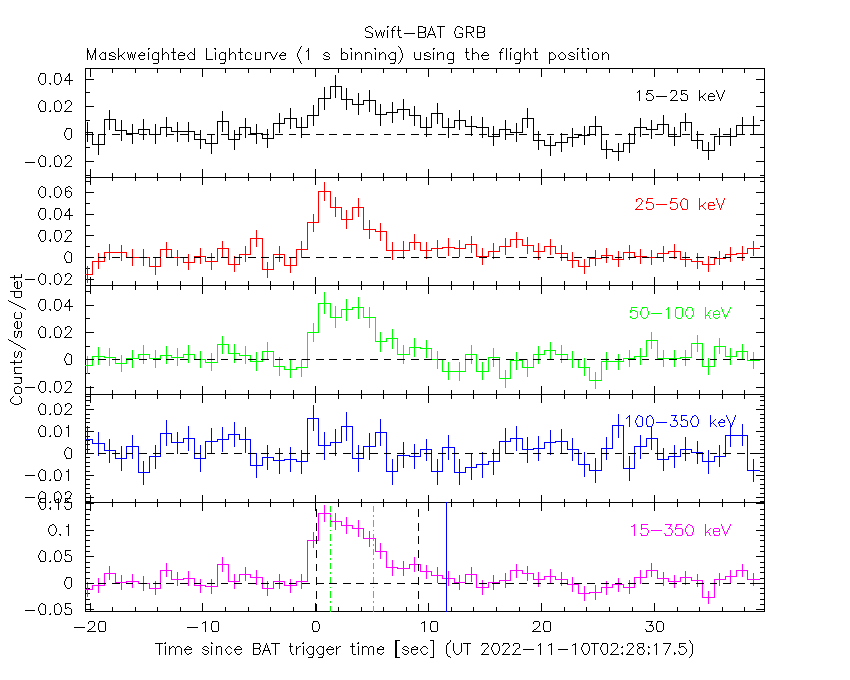
M.A. Williams (PSU), J.D. Gropp (PSU) and S.J. LaPorte (PSU) for the Swift team
At 02:28:17 UT, the Swift Burst Alert Telescope (BAT) triggered and located GRB 221110A (trigger=1136936) (Williams et al. GCN Circ. 32925). Swift slewed immediately to the burst. At the time of the trigger, the initial BAT position was 133° from the Sun (10.9 hours East) and 61° from the 97%-illuminated Moon. Table 1 contains the best reported positions from Swift, and the latest XRT position can be viewed at http://www.swift.ac.uk/xrt_positions.
Lipunov et al. (GCN Circ. 32924) reported the position from MASTER for the optical afterglow of this GRB. Williams et al. (GCN Circ. 32925) reported the detection with UVOT of an optical afterglow. Izzo et al. (GCN Circ. 32928) determined a redshift of 4.06 from VLT. Table 2 is a summary of GCN Circulars about this GRB from observatories other than Swift.
Standard analysis products for this burst are available at https://gcn.gsfc.nasa.gov/swift_gnd_ana.html.
As reported by Parsotan et al. (GCN Circ. 32931),
the BAT ground-calculated position is RA, Dec = 29.106, -27.298 deg which is RA(J2000) = 0
The mask-weighted light curve (Figure 1) shows a single-pulse structure that starts at ~
The time-averaged spectrum from T-0.41 to T+9.74 s is best fit by a simple power-law model.
The power law index of the time-averaged spectrum is 1.41 ± 0.16.
The fluence in the 15-150 keV band is 5.1 ± 0.5 x 1
The results of the batgrbproduct analysis are available at https://gcn.gsfc.nasa.gov/notices_s/1136936/BA/.
Analysis of the initial XRT data was reported by Gropp et al. (GCN Circ. 32930). We have analysed 29 ks of XRT data for GRB 221110A, from 64 s to 434.7 ks after the BAT trigger. The data comprise 55 s in Windowed Timing (WT) mode (the first 9 s were taken while Swift was slewing) with the remainder in Photon Counting (PC) mode. The enhanced XRT position for this burst was given by Evans et al. (GCN Circ. 32929).
The light curve (Figure 2) can be modelled with a power-law decay with a decay index of α=0.950 (+0.023, -0.022).
A spectrum formed from the PC mode data can be fitted with an absorbed power-law with a photon spectral index of 1.88 ± 0.15. The best-fitting absorption column is 8 (+14, -8) x 1
A summary of the PC-mode spectrum is thus:
Galactic foreground: 1.5 x 1
Intrinsic column: 8 (+14, -8) x 1
Photon index: 1.88 ± 0.15
The results of the XRT team automatic analysis are available at http://www.swift.ac.uk/xrt_products/01136936.
The Swift/UVOT began settled observations of the field of GRB 221110A 83 s after the BAT trigger
(LaPorte and Williams GCN Circ. 32932).
Table 3 gives preliminary
magnitudes using the UVOT photometric system
(Breeveld et al. 2011, AIP Conf. Proc., 1358, 373).
No correction has been made for the expected extinction in the Milky Way
corresponding to a reddening of

Figure 1. The BAT
mask-weighted light curve in the four individual and total
energy bands. The units are counts

Figure 2. The XRT light curve.
Any data from a crosshatched region are not included in the fit.
| RA (J2000) | Dec (J2000) | Error | Note | Reference |
|---|---|---|---|---|
| 0 |
-27°17'36.9" | 0.5" | UVOT-initial | Williams et al. GCN Circ. 32925 |
| 0 |
-27°17'44.5" | 2.1" | XRT-final | UKSSDC |
| 0 |
-27°17'42.7" | 2.2" | XRT-enhanced | Evans et al. GCN Circ. 32929 |
| 0 |
-27°17'51.4" | 1.5' | BAT-refined | Parsotan et al. GCN Circ. 32931 |
| Band | Authors | GCN Circ. | Subject | Observatory | Notes |
|---|---|---|---|---|---|
| Optical | Lipunov et al. | 32923 | Swift GRB221110.10: Global MASTER-Net observations report |
MASTER | |
| Optical | Lipunov et al. | 32924 | Swift GRB221110.10: Global MASTER-Net OT detection |
MASTER | detection |
| Optical | Strausbaugh and Cucchiara | 32926 | LCOGT Optical Afterglow Detection | Las Cumbres Obs. Global Tele.Network | detection |
| Optical | Watson et al. | 32927 | COATLI Afterglow detection | COATLI | detection |
| Optical | Izzo et al. | 32928 | VLT/X-shooter redshift | VLT | redshift |
| Optical | 32933 | GMG upper limit | Gao-Mei-Gu | upper limits | |
| Optical | Watson et al. | 32935 | COATLI Second-Epoch Upper Limits | COATLI | upper limits |
| Optical | Coughlin et al. | 32939 | GRANDMA observations | GRANDMA |
| Filter | Exp(s) | Mag | ||
|---|---|---|---|---|
| b | 3773 | 3973 | 196 | >19.91 |
| m2 | 4593 | 4793 | 196 | >19.35 |
| u | 326 | 439 | 110 | >19.33 |
| v | 4357 | 4557 | 197 | >19.5 |
| w1 | 4798 | 4998 | 196 | >19.48 |
| w2 | 4184 | 4383 | 196 | >19.55 |
| whit |
114 | 264 | 147 | 18.68± 0.08 |
| white | 3978 | 4178 | 196 | >20.66 |
Table 3. UVOT observations reported by LaPorte and Williams (GCN Circ. 32932). The start and stop times of the exposures are given in seconds since the BAT trigger. The preliminary detections and 3-σ upper limits are given. No correction has been made for extinction in the Milky Way.
November 16, 2022